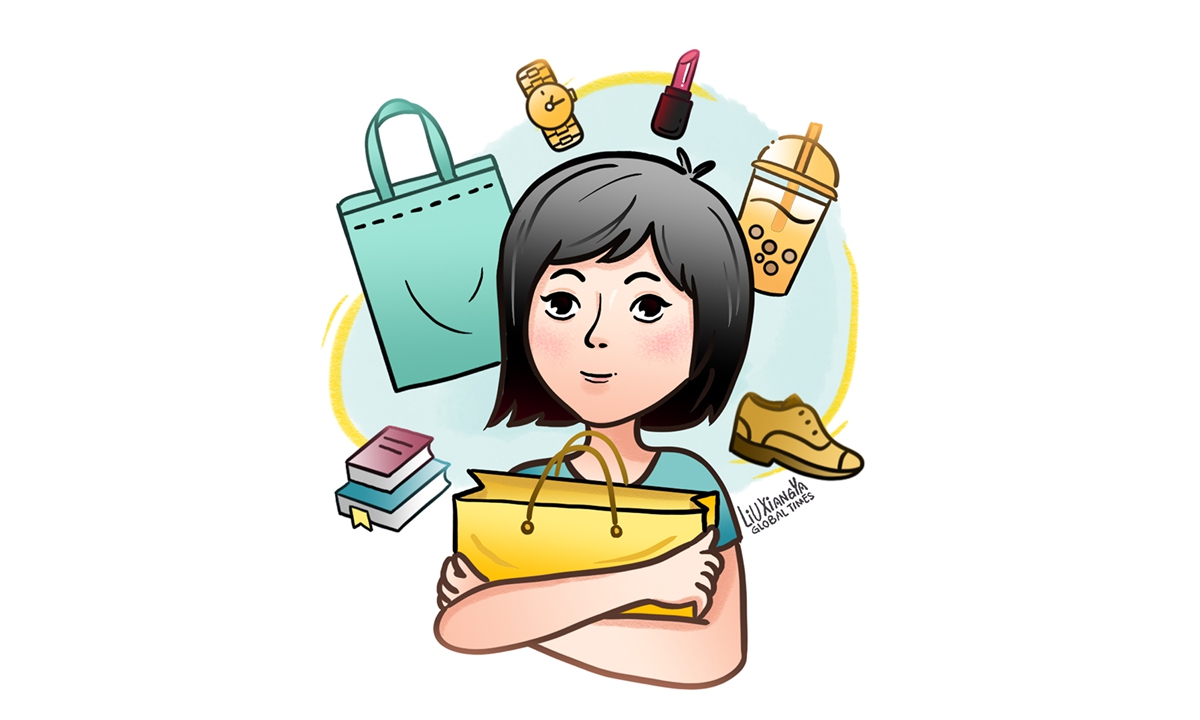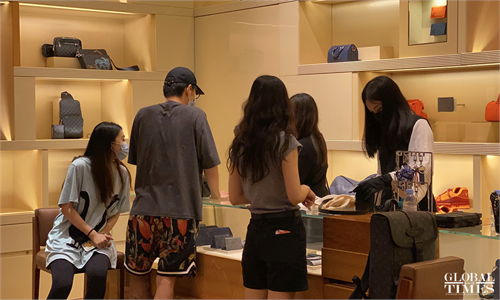ARTS / CULTURE & LEISURE
Smart or superficial? Buying luxury co-branded products

Illustration: Liu Xiangya/Global Times
Recently, long queues have popped up outside three coffee shops in downtown Shanghai, and even scalpers have appeared. However, they are not waiting for coffee.
These three coffee shops have joined hands with a luxury fashion brand to launch time-limited bookstores where consumers can get a canvas bag with a printed logo as a complimentary item after buying two items (excluding coffee) whose prices vary from 290 yuan ($40) to 20,000 yuan.
Some consumers said they are book lovers and curious about publications from a luxury brand, and some indicated they are not there for the books but for the logo bag. While many of them seem enthusiastic about the event, many netizens online said they think spending at least 580 yuan for a canvas bag is paying a "tax for stupidity."
In contrast, others see it a cost-effective choice. This is not the first time such a co-branding strategy has taken place in China involving luxury brands. For example, a trendy Chinese tea chain store recently collaborated with an Italian luxury fashion brand to launch a time-limited co-branded drink at 19 yuan per cup. According to a trending topic in May, some people have even been able to sell a used cup at 10 yuan online.
Nowadays, co-branding between the beverage market and high-end goods is an increasingly sought-after marketing strategy due to its striking influence. So, what are the factors that have led to this phenomenon?
To begin with, there is enormous market potential and fierce competition. According to third-party data mining and analysis organization iiMedia Research, China's coffee market has been multiplying, with the market size reaching 485.6 billion yuan in 2022. It further predicts that the market will grow to 1.2 trillion yuan by 2025. More market-sensitive players are making their way into the industry.
Naturally, pressure from business competitors drives players to constantly innovate and make breakthroughs, catering to consumers' diverse and personalized needs and differentiating themselves for new growth points, thus increasing exposure and strengthening, or even expanding, their brand awareness.
At the same time, through cross-border co-branding, coffee and tea brands can also engage in cultural exchanges and collision with luxury brands, integrating the characteristics and styles of both sides and creating more distinctive and meaningful products.
By cooperating with the luxury brand, the coffee shops demonstrated their willingness to promote and support integrating culture, thus upgrading their reputation to some extent. It also attracted the attention of a large number of consumers with its originality and uniqueness.
The luxury brand also needs to enhance and explore the market, approaching more consumers, mainly targeting young people. A smart way is gaining favor in their daily life and increasing brand loyalty.
Moreover, today's consumer society, unlike the traditional producer society in which consumer behavior is based on their actual needs, is highlighted by symbol consumption; namely, consumers want not only a material product but also a symbol that expresses their identity and social status.
Consumers now focus instead on the story and intangible value behind a product rather than the functionality and quality of the product itself. As mass media and popular fashion increasingly influence most people's value orientation, a symbolic good is easily recognized as a name card, and the owner is labeled accordingly.
When you buy something trendy, you are allocated to the trendy group. Amid the popularization of symbols, different types of consumers have reached a consensus concerning what these symbols mean, and the direct impact is that most people tend to conform to the latest trends to manifest their status and taste.
While paying a premium is seen as stupid and irrational behavior, deviating from traditional economic theory, it can also be accepted from the perspective of evolution because people are likely to do things that seem irrational but ultimately benefit themselves.
In other words, individuals may act contrary to conventional behavioral norms to highlight their uniqueness, which is, in essence, a strategy to gain additional attention, rewards, or competitive advantages over others.
However, luxury consumption may make people enter into a vortex of blind consumption if they are driven by social pressure, advertisements, and identity recognition out of vanity, notably exceeding what they can actually afford.
In this situation, such consumer behavior may adversely affect resource allocation and values, which is essentially an irresponsible path for ourselves.
Therefore, we need to seek a balance between personal choices and social responsibility, while encouraging consumers to enjoy consumption and think and treat luxury goods more rationally.
The author is a faculty member with the School of Applied Economics, Renmin University of China. life@globaltimes.com.cn

